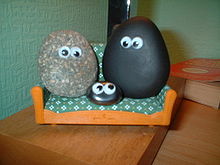| Revision as of 19:44, 5 April 2023 edit2a02:c7f:2c51:fd00:1d8b:cb42:76fd:c1f5 (talk) Makes no senseTags: Visual edit Mobile edit Mobile web edit← Previous edit | Revision as of 18:42, 30 April 2023 edit undoMorgan695 (talk | contribs)Autopatrolled, Extended confirmed users42,576 edits →List of novelty itemsNext edit → | ||
| Line 64: | Line 64: | ||
| * ] | * ] | ||
| * ] | * ] | ||
| * ] | |||
| {{div col end}} | {{div col end}} | ||
Revision as of 18:42, 30 April 2023
| This article does not cite any sources. Please help improve this article by adding citations to reliable sources. Unsourced material may be challenged and removed. Find sources: "Novelty item" – news · newspapers · books · scholar · JSTOR (December 2022) (Learn how and when to remove this message) |
A novelty item is an object which is specifically designed to serve no practical purpose, and is sold for its uniqueness, humor, or simply as something new (hence "novelty", or newness). The term also applies to practical items with fanciful or nonfunctional additions, such as novelty aprons, slippers, or toilet paper. The term is normally applied to small objects, and is generally not used to describe larger items such as roadside attractions. Items may have an advertising or promotional purpose, or be a souvenir.
Usage
This term covers a range of small manufactured goods, such as collectables, gadgets and executive toys. Novelty items are generally devices that do not primarily have a practical function. Toys for adults are often classed as novelties. Some products have a brief period as a novelty item when they are actually new, only to become an established, commonly used product, such as the Hula Hoop or the Frisbee.
Others may have an educational element, such as a Crookes radiometer, Newton's cradle, or drinking bird. Sex toys are often described as novelty items (varying from this definition, as they do serve a practical purpose), and some products sold in sex shops may not have any practical sexual function, if operating primarily as a humorous gift, such as sex dice. Some food products may be considered novelty items, especially when first introduced, such as deep-fried Mars bars.
History



The French mathematician and astronomer Pierre Hérigone (1580–1643) describes a novelty item that was a camera obscura in the form of a goblet. Hérigone's device was constructed so that the user could spy on others while taking a drink. Its 45-degree mirror had a stylized opening for the lens and the lid bore a magnifying lens at the top.
Lenticular printing was developed in the 1940s, and is used extensively in the production of novelty items. Paper clothing, which has some practical purpose, was briefly novel in the United States in the 1960s.
One of the more popular novelty items in recent history was the singing Big Mouth Billy Bass, manufactured by Gemmy Industries. It is estimated that over 20 million original pieces were sold in 12 months during 2000 and 2001.
Novelty items based on mathematical objects, such as Klein bottles and Penrose triangles, have been manufactured. Models of Möbius strips are sometimes made in place of regular bands, such as rings.
List of novelty items
This is a dynamic list and may never be able to satisfy particular standards for completeness. You can help by adding missing items with reliable sources.- Big Mouth Billy Bass
- Bobblehead
- Bubble pipe
- BunaB
- Chattering teeth
- Cheesehead
- Chinese finger trap
- Crookes radiometer
- Deely bobber
- Drinking bird
- Dehydrated water
- Expandable water toy
- Garden gnome
- Groucho glasses
- Horse head mask
- Joy buzzer
- Kit-Cat Klock
- Lava lamp
- Magic 8-Ball
- Mexican jumping bean
- New Year's glasses
- Newton's cradle
- Novelty lighter
- Pet Rock
- Plasma globe
- Plastic flamingo
- Propeller beanie
- Radio hat, while a practical item, was a novelty when it first appeared
- Silly Putty
- Slime
- Slinky
- Snow globe
- Squirmle
- Talking clock
- Toffee hammer
- Trammel of Archimedes
- Umbrella hat
- Useless machine
- Viking helmets
- Whoopee cushion
- X-Ray specs
- Yaoi paddle
See also
- Bric-à-brac
- Chindōgu, Japanese neologism for an "unuseless" invention
- Ephemera
- Notion (accessory)
- Practical joke device
- Souvenir
Further reading
- Mark Newgarden, Cheap Laffs: The Art of the Novelty Item, Abrams Books/PictureBox, 2004.